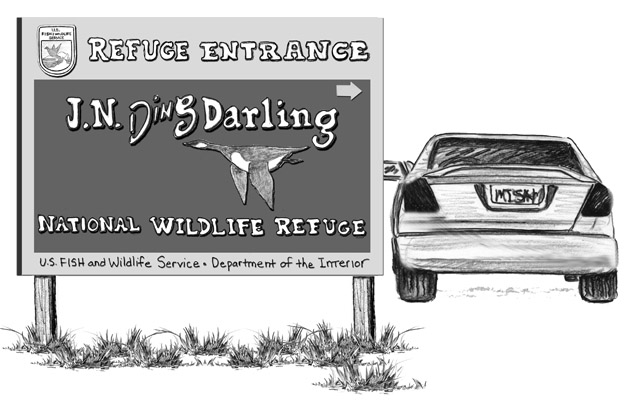
Dear Bird Folks,
I’m going to Florida next month and among other things I plan on doing some bird watching. Everyone tells me that I definitely need to visit a place called the Ding Darling Wildlife Refuge. They say it’s the best place in the state for birding. Have you ever been there? Do you think it’s worth a visit?
– Betsy, Sandwich, MA
Your timing is perfect, Betsy,
Surprisingly, my son Casey and I are actually headed to Florida tomorrow and, not so surprisingly, we also plan to do some birding. I wasn’t planning on going to the Ding Darling Wildlife Refuge (I’ve been many times before), but since my son – and now you- are interested in the place, I guess it’s off to Ding Darling I go. (Wasn’t Off to Ding Darling I Go a song the Dwarfs sang in Snow White? Yes, I think it was.) We have Ding Darling penciled in for day number three of our trip. I’ll give you a full report after our visit. Stay tuned.
Okay, I’m back. You’ll be happy to know that the Ding Darling National Wildlife Refuge is still there. In fact, for the 35th year in a row Ding Darling has been voted the wildlife refuge with the funniest name. Actually, Jay Norwood “Ding” Darling was a Pulitzer Prize winning political cartoonist who did great work in the name of conservation and habitat preservation. This beautiful refuge is named in his honor. (It’s still a funny name, though.) The vast property covers over 5,200 acres and we checked out every single acre just for you, Betsy. In reality, we spent most of the time exploring the refuge’s famous four-mile wildlife drive. This is where most casual birders with limited time should go. Tons of birds can easily be seen without ever getting out of the car. (That’s my kind of birding.)
The first thing you need to know is that this wildlife refuge is located off Florida’s west coast, near the town of Fort Myers, on the island of Sanibel. Even though Sanibel is an island, you don’t have to deal with a boat to get there. The island is connected to the mainland by a rather fancy bridge. And just like the bridges on Cape Cod, there can be traffic issues. (It will make you feel right at home.) FYI: the authorities welcome you to Sanibel by charging a whopping six bucks just for crossing the bridge. Six bucks! And once you get on the island don’t plan on going anywhere in a hurry. The legal speed limit on Sanibel is four MPH…or so it would seem.
The wildlife refuge opens at 7:00 AM. Like most good birders, my son and I arrived at the crack of 10:30 (such is life when birding with a teenager). A wonderful visitors center greets you as you enter the property. It has restrooms, plenty of smart people to answer questions and a superb gift shop that even carries a supply of my book. (I told you the place was superb.) The entrance fee to the wildlife drive is $5.00 per car, or $1.00 if you want to go green and walk the loop. Keep in mind that the four-mile drive is a one-way loop, so you won’t be able to quickly return to the visitors center if you decide you need to use the restrooms or buy another copy of my book. Another FYI: The wildlife drive is closed every Friday to give the birds a break, and it will be closed every day this summer (between May and September 2013) for resurfacing. So don’t go then or you’ll be disappointed. (But anyone who leaves Cape Cod in the summer to go to Florida deserves to be disappointed.)
The refuge’s loop-road has several good areas to stop and observe water birds. The birds are usually close up and most of the time a pair of binoculars is all you’ll need to see them. (Although the hardcores will want to use a spotting scope to sniff out the birds hiding in the mangrove shadows.) With little effort you should expect to see such majestic birds as the stately American White Pelican and the heart-stopping Roseate Spoonbill. The vast tidal lagoons attract just about every heron, egret and ibis you can imagine. In addition, the mudflats are a magnet for an assortment of wintering shorebirds. The Ding Darling Wildlife Refuge boasts a species list that contains over 220 birds, and on this particular day my son and I saw nearly all of them…well, nearly all except for 198. (It wasn’t our best day.) We unfortunately arrived at high tide and the water was a bit too deep for some of the waders. In addition, about halfway through the loop I spotted a yellow rat snake and spent the rest of the time sitting in the car, with the doors locked, surrounded by a ring of fire.
I have mixed feelings about the Ding Darling Wildlife Refuge (and not just because of the snake). The first time I visited the refuge (33 years ago), it blew me away. But since then I’ve birded in Florida many times and have begun to realize that most of the birds seen at Ding Darling can be seen at a variety of birding places in the state and none of those places charge six bucks just to cross a bridge.
Should you go to Ding Darling, Betsy? You absolutely should, but only if you are in the area. Florida has lots of fine wildlife refuges, state parks and birding locations that are just as good or better. Tomorrow we head to Florida’s east coast to explore some new birding spots that I’ve just heard about. I’ll report to you about those places next week…if the rat snakes (and pythons) don’t get me. So once again, stay tuned.